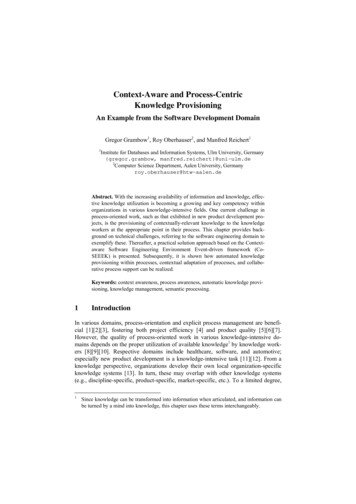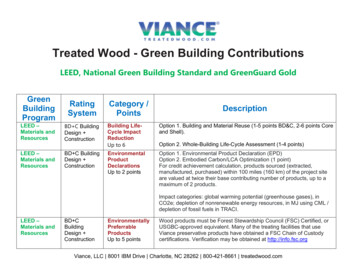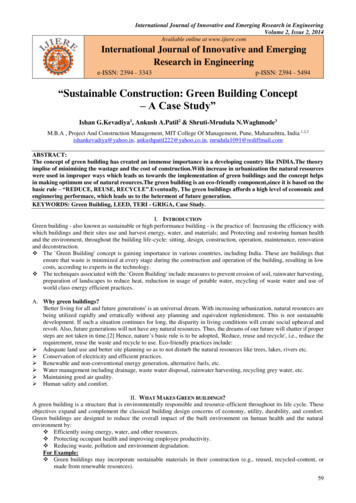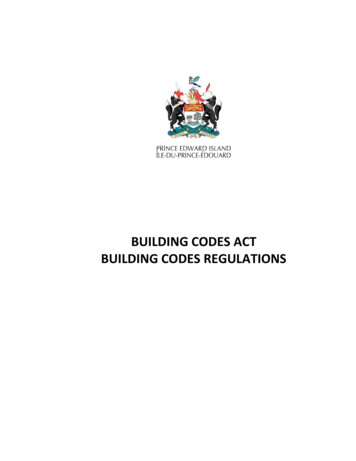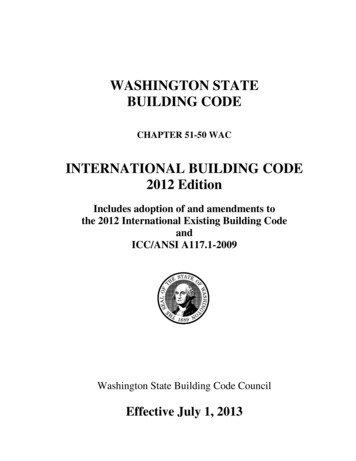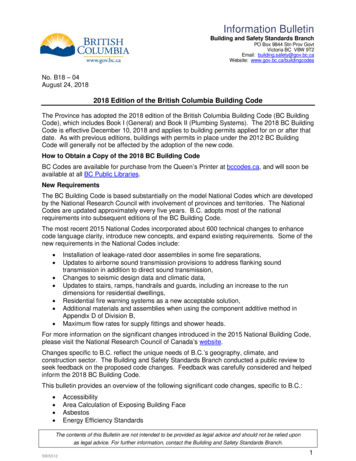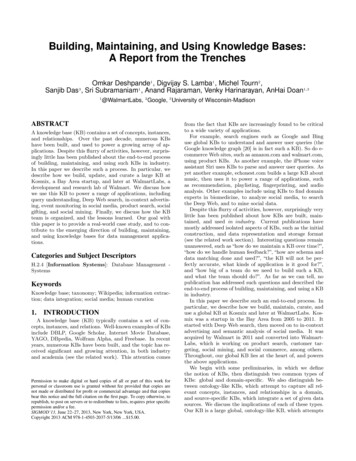
Transcription
Building, Maintaining, and Using Knowledge Bases:A Report from the TrenchesOmkar Deshpande1 , Digvijay S. Lamba1 , Michel Tourn2 ,Sanjib Das , Sri Subramaniam1 , Anand Rajaraman, Venky Harinarayan, AnHai Doan1,331@WalmartLabs, 2 Google, 3 University of Wisconsin-MadisonABSTRACTA knowledge base (KB) contains a set of concepts, instances,and relationships. Over the past decade, numerous KBshave been built, and used to power a growing array of applications. Despite this flurry of activities, however, surprisingly little has been published about the end-to-end processof building, maintaining, and using such KBs in industry.In this paper we describe such a process. In particular, wedescribe how we build, update, and curate a large KB atKosmix, a Bay Area startup, and later at WalmartLabs, adevelopment and research lab of Walmart. We discuss howwe use this KB to power a range of applications, includingquery understanding, Deep Web search, in-context advertising, event monitoring in social media, product search, socialgifting, and social mining. Finally, we discuss how the KBteam is organized, and the lessons learned. Our goal withthis paper is to provide a real-world case study, and to contribute to the emerging direction of building, maintaining,and using knowledge bases for data management applications.Categories and Subject DescriptorsH.2.4 [Information Systems]: Database Management SystemsKeywordsKnowledge base; taxonomy; Wikipedia; information extraction; data integration; social media; human curation1.INTRODUCTIONA knowledge base (KB) typically contains a set of concepts, instances, and relations. Well-known examples of KBsinclude DBLP, Google Scholar, Internet Movie Database,YAGO, DBpedia, Wolfram Alpha, and Freebase. In recentyears, numerous KBs have been built, and the topic has received significant and growing attention, in both industryand academia (see the related work). This attention comesPermission to make digital or hard copies of all or part of this work forpersonal or classroom use is granted without fee provided that copies arenot made or distributed for profit or commercial advantage and that copiesbear this notice and the full citation on the first page. To copy otherwise, torepublish, to post on servers or to redistribute to lists, requires prior specificpermission and/or a fee.SIGMOD’13, June 22–27, 2013, New York, New York, USA.Copyright 2013 ACM 978-1-4503-2037-5/13/06 . 15.00.from the fact that KBs are increasingly found to be criticalto a wide variety of applications.For example, search engines such as Google and Binguse global KBs to understand and answer user queries (theGoogle knowledge graph [20] is in fact such a KB). So do ecommerce Web sites, such as amazon.com and walmart.com,using product KBs. As another example, the iPhone voiceassistant Siri uses KBs to parse and answer user queries. Asyet another example, echonest.com builds a large KB aboutmusic, then uses it to power a range of applications, suchas recommendation, playlisting, fingerprinting, and audioanalysis. Other examples include using KBs to find domainexperts in biomedicine, to analyze social media, to searchthe Deep Web, and to mine social data.Despite this flurry of activities, however, surprisingly verylittle has been published about how KBs are built, maintained, and used in industry. Current publications havemostly addressed isolated aspects of KBs, such as the initialconstruction, and data representation and storage format(see the related work section). Interesting questions remainunanswered, such as “how do we maintain a KB over time?”,“how do we handle human feedback?”, “how are schema anddata matching done and used?”, “the KB will not be perfectly accurate, what kinds of application is it good for?”,and “how big of a team do we need to build such a KB,and what the team should do?”. As far as we can tell, nopublication has addressed such questions and described theend-to-end process of building, maintaining, and using a KBin industry.In this paper we describe such an end-to-end process. Inparticular, we describe how we build, maintain, curate, anduse a global KB at Kosmix and later at WalmartLabs. Kosmix was a startup in the Bay Area from 2005 to 2011. Itstarted with Deep Web search, then moved on to in-contextadvertising and semantic analysis of social media. It wasacquired by Walmart in 2011 and converted into WalmartLabs, which is working on product search, customer targeting, social mining, and social commerce, among others.Throughout, our global KB lies at the heart of, and powersthe above applications.We begin with some preliminaries, in which we definethe notion of KBs, then distinguish two common types ofKBs: global and domain-specific. We also distinguish between ontology-like KBs, which attempt to capture all relevant concepts, instances, and relationships in a domain,and source-specific KBs, which integrate a set of given datasources. We discuss the implications of each of these types.Our KB is a large global, ontology-like KB, which attempts
to capture all important and popular concepts, instances,and relationships in the world. It is similar to Freebase andGoogle’s knowledge graph in this aspect.Building the KB: We then discuss building the KB.Briefly, we convert Wikipedia into a KB, then integrate itwith additional data sources, such as Chrome (an automobile source), Adam (health), MusicBrainz, City DB, andYahoo Stocks. Here we highlight several interesting aspectsthat have not commonly been discussed in the KB construction literature. First, we show that converting Wikipediainto a taxonomy is highly non-trivial, because each node inthe Wikipedia graph can have multiple paths (i.e., lineages)to the root. We describe an efficient solution to this problem. Interestingly, it turned out that different applicationsmay benefit from different lineages of the same node. Sowe convert Wikipedia into a taxonomy but do preserve alllineages of all Wikipedia nodes.Second, extracting precise relationships from Wikipedia(and indeed from any non-trivial text) is notoriously difficult. We show how we sidestep this problem and extract“fuzzy relationships” instead, in the form of a relationshipgraph, then use this fuzzy relationship graph in a variety ofreal-world applications.Third, we discuss extracting meta information for thenodes in the KB, focusing in particular on social information such as Wikipedia traffic statistics and social contexts.For example, given the instance “Mel Gibson”, we store thenumber of times people click on the Wikipedia page associated with it, the most important keywords associated withit in social media in the past 1 hour (e.g., “mel”, “crash”,“maserati”), and so on. Such meta information turns out tobe critical for many of our applications.Finally, we discuss adding new data sources to the KBconstructed out of Wikipedia. We focus in particular onmatching external instances into those in the KB, and brieflydiscuss how taxonomy matching and entity instance matching are interwoven in our algorithm.Maintaining and Curating the KB: Building the initialKB is difficult, but is just the very first step. In the long run,maintaining and curating the KB pose the most challengesand incur most of the workload. We discuss how to refreshthe KB every day by rerunning most of it from the scratch(and the reason for doing so). We then discuss a majortechnical challenge: how to curate the KB and preserve thecuration after refreshing the KB. Our solution is to capturemost of the human curation in terms of commands, and thenapply these commands again when we refresh the KB.Using the KB: In the last major part of the paper, wediscuss how we have used the above KB for a variety of applications, including parsing and understanding user queries,Deep Web search, in-context advertising, semantic analysisof social media, social gifting, and social mining. We discuss the insights gleaned from using an imperfect KB inreal-world applications.Finally, we describe the organization of the team thatworks on the KB, statistics regarding the KB, lessons learned,future work, and comparison to related work. A technicalreport version of this paper, with more details, can be foundat pages.cs.wisc.edu/ anhai/papers/kcs-tr.pdf.2.PRELIMINARIESKnowledge Bases:A knowledge base typically consistsFigure 1: A tiny example of a KBof a set of concepts C1 , . . . , Cn , a set of instances Ii for eachconcept Ci , and a set of relationships R1 , . . . , Rm among theconcepts.We distinguish a special relationship called “is-a”, whichspecifies that a concept A is a kind of a concept B (e.g.,Professors is a kind of People). The “is-a” relationships impose a taxonomy over the concepts Ci . This taxonomy is atree, where nodes denote the concepts and edges the “is-a”relationships, such that an edge A B means that conceptB is a kind of concept A. Figure 1 shows a tiny KB, whichillustrates the above notions.In many KBs, the set of instances of a parent node (in thetaxonomy) is the union of the instances of the child nodes.In our context, we do not impose this restriction. So a nodeA may have instances that do not belong to any of A’s children. Furthermore, KBs typically also contain many domainintegrity constraints. In our context, these constraints willappear later, being specified by our developers as a part ofthe human curation process (see Section 4.2).Domain-Specific KBs vs. Global KBs:We distinguish two types of KBs. A domain-specific KB captures concepts, instances, and relationships of a relatively well-defineddomain of interest. Examples of such KBs include DBLP,Google Scholar, DBLife, echonest, and product KBs beingbuilt by e-commerce companies. A global KB attempts tocover the entire world. Examples of such KBs include Freebase, Google’s knowledge graph, YAGO, DBpedia, and thecollection of Wikipedia infoboxes.This distinction is important because depending on thetarget applications, we may end up building one type or theother. Furthermore, it is interesting to consider whether weneed domain-specific KBs at all. To power most of realworld applications, is it sufficient to build just a few largeglobal KBs? If so, then perhaps they can be built with bruteforce, by big Internet players with deep pocket. In this case,developing efficient methodologies to build KBs presumablybecome far less important.We believe, however, that while global KBs are very important (as ours attests), there is also an increasing need tobuild domain-specific KBs, and in fact, we have seen thisneed in many domains. Consequently, it is important to develop efficient methodologies to help domain experts buildsuch KBs as fast, accurately, and inexpensively as possible.Ontology-like KBs vs. Source-Specific KBs: We alsodistinguish between ontology-like and source-specific KBs.An ontology-like KB attempts to capture all important concepts, instances, and relationships in the target domain. Itfunctions more like a domain ontology, and is comprehensive in certain aspects. For example, DBLP is an ontologylike KB. It does not capture all possible relationships in
Figure 2: Two main kinds of Wikipedia pages - article page (left) and category page (right)the CS publication domains, but is comprehensive in that itcontains all publications of the most important publicationvenues. An ontology-like KB can also be viewed as a kindof “dictionary” for the target domain.Source-specific KBs, in contrast, are built from a given setof data sources (e.g., RDBMSs, semi-structured Web pages,text), and cover these sources only. For example, an intelligence analyst may want to build a KB that covers all articlesin the past 30 days from all major Middle-East newspapers,for querying, mining, and monitoring purposes.The above distinction is important for two reasons. First,building each type of KB requires a slightly different set ofmethods. Building a source-specific KB is in essence a dataintegration problem, where we must integrate data from agiven set of data sources. The KB will cover the concepts,instances, and relations found in these sources and theseonly. In contrast, building an ontology-like KB requires aslightly different mindset. Here we need to think “I want toobtain all information about this concept and its instances,where in the world can I obtain this information, in the mostclean way, even if I have to buy it?”. So here the step of datasource acquisition becomes quite prominent, and obtainingthe right data source often makes the integration problemmuch easier.Second, if we already have an ontology-like KB, buildingsource-specific KBs in the same domain becomes much easier, because we can use the ontology-like KB as a domaindictionary to help locate and extract important informationfrom the given data sources (see Section 6). This underscores the importance of building ontology-like KBs, andefficient methodologies to do so.Given that our applications are global in scope, our goal isto build a global KB. We also want this KB to be ontologylike, in order to use it to build many source-specific KBs.We now describe how we build, maintain, curate, and usethis global, ontology-like KB.3.BUILDING THE KNOWLEDGE BASEAs we hinted earlier, Wikipedia is not a KB in the traditional sense, and converting Wikipedia into a KB is a nontrivial process. The key steps of this process are: (1) constructing the taxonomy tree from Wikipedia, (2) constructing a DAG on top of the taxonomy, (3) extracting relationships from Wikipedia, (4) adding metadata, and (5) addingother data sources. We now elaborate on these steps.Figure 3: Cyclic references in a Wikipedia categorypage3.1 Constructing the Taxonomy Tree1. Crawling Wikipedia: We maintain an in-house mirror of Wikipedia and keep it continuously updated, by monitoring the Wikipedia change log and pulling in changes asthey happen. Note that an XML dump of Wikipedia pagesis also available at download.wikimedia.org/enwiki. However, we maintain the Wikipedia mirror because we want toupdate our KB daily, whereas the XML dump usually getsupdated only every fortnight.2. Constructing the Wikipedia Graph: There are twomain kinds of pages in Wikipedia: article pages and categorypages (see Figure 2). An article page describes an instance.A category page describes a concept. In particular the pagelists the sub-categories, parent categories, and article children. Other Wikipedia page types include Users, Templates,Helps, Talks, etc., but we do not parse them. Instead, weparse the XML dump to construct a graph where each noderefers to an article or a category, and each edge refers to aWikipedia link from a category X to a subcategory of X orfrom a category X to an article of X.Ideally, the articles (i.e., instances) and categories (i.e.,
compute a (normalized) count of how frequently theyoccur together in Web pages, using a large in-houseWeb corpus. Intuitively, the higher this count, thestronger the relationship between the two concepts,and thus the edge between them. Co-occurrence count of the two concepts forming theedge in lists: This is similar to the above signal, except that we look for co-occurrences in the same listin Wikipedia.Figure 4: Constructing the top levels of our taxonomy and the list of verticalsconcepts) should form a taxonomy, but this is not the case.The graph produced is cyclic. For example, Figure 3 showsthe category page “Category:Obama family”. This categorypage lists the page “Category:Barack Obama” as a subcategory. But it also lists (at the bottom of the page) thesame page as a parent category. So this page and the page“Category:Barack Obama” form a cycle. As a result, theWikipedia graph is a directed cyclic graph.Another problem with this graph is that its top categories,shown in Figure 4 as “Contents”, “Wikipedia administration”, “Wikipedia categories”, etc. are not very desirablefrom an application point of view. The desirable categories,such as “Philosophy” and“Diseases and Disorders” are buriedseveral levels down in the graph. To address this problem,we manually create a set of very high-level concepts, suchas “KosmixHealth”, “KosmixSocialSciences”, and “KosmixHistory”, then place them as the children of a root node.We call these nodes verticals. Next, we place the desirableWikipedia categories in the first few levels of the graph asthe children of the appropriate verticals, see Figure 4. Thisfigure also lists all the verticals in our KB.3. Constructing the Taxonomy Tree:We now describe how to construct a taxonomic tree out of the directedcyclic Wikipedia graph. Several algorithms exist for converting such a graph to a spanning tree. Edmonds’ algorithm(a.k.a. Chu-Liu/Edmonds’) [12, 9] is a popular algorithmfor finding the maximum or minimum number of optimumbranchings in a directed graph. We use Tarjan [23], an efficient implementation of this algorithm.Tarjan prunes edges based on associated weights. So weassign to each edge in our graph a weight vector as follows.First, we tag all graph edges: category-article edges withwarticle and category-subcategory edges with wsubcat. Ifan article and its parent category happen to have the samename (e.g., “Article:Socrates” and “Category:Socrates”), theedge between them is tagged with artcat. We then assigndefault weights to the tags, with artcat, wsubcat, and warticlereceiving weights in decreasing order.Next, we compute a host of signals on the edges. Examplesinclude: Co-occurrence count of the two concepts forming theedge on the Web: Given two concepts A and B, we Similarity between the concept names: We compute thesimilarity between the concept names, using a set ofrules that take into account how Wikipedia categoriesare named. For example, if we see two concepts withnames such as “Actors” and “Actors by Nationality”(such examples are very common in Wikipedia), weknow that they form a clean parent-child relationship,so we assign a high signal value to the edge betweenthem.Next, an analyst may (optionally) assign two types of weightto the edges: recommendation weights and subtree preference weights. The analyst can recommend an ancestor Ato a node B by assigning a recommendation weight to theedges in the path from A to B. He or she can also suggestthat a particular subtree in the graph is highly relevant andshould be preserved as far as possible during pruning. Todo so, the analyst assigns a high subtree preference weightsto all the edges in that subtree, using an efficient commandlanguage. For more details see Section 4.2, where we explainthe role of an analyst in maintaining and curating the KB.Now we can assign to each edge in the graph a weightvector, where the weights are listed in decreasing order ofimportance: recommendation weight, subtree preferenceweight, tag weight, signal 1, signal 2, . . Comparingtwo edges means comparing the recommendation weights,then breaking tie by comparing the next weights, and so on.The standard Edmonds’ algorithm works with just a singleweight per edge. So we modified it slightly to work with theweight vectors.3.2 Constructing the DAGTo motivate DAG construction, suppose that the articlepage “Socrates” is an instance of category “Forced Suicide”,which in turn is a child of two parent categories: “AncientGreek Philosophers” and “5th Century BC Philosophers”.These two categories in turn are children of “Philosophers”,which is a child of “ROOT”.Then “Forced Suicide” has two lineages to the root: L1 Force Suicide - Ancient Greek Philosophers - Philosophers ROOT, and L2 Force Suicide - 5th Century BC Philosophers - Philosophers - ROOT. When constructing the taxonomic tree, we can select only one lineage (since each nodecan have only one path to the root). So we may select lineageL1 and delete lineage L2 . But if we do so, we lose information. It turns out that keeping other lineages such as L2around can be quite beneficial for a range of applications.For example, if a user query refers to “5th century BC”,then keeping L2 will boost the relevance of “Socrates” (sincethe above phrase is mentioned on a path from “Socrates” tothe root). As yet another example, Ronald Reagan has twopaths to the root, via “Actors” and “US Presidents”, and it isdesirable to keep both, since an application may make use of
Figure 5: Extraction of relationships from a Wikipedia pageeither. We would want to designate a lineage as the primaryone (e.g., “US Presidents” in the case of Ronald Reagan sincehe is more well known for that), by making that lineage as apart of the taxonomy, while keeping the remaining lineages(e.g., “Actors”).Consequently, we want to construct a primary taxonomictree from the Wikipedia graph, but we also want to keep allother lineage information, in the form of a DAG that subsumes the taxonomic tree. Recall that the Wikipedia graphhas cycles. We however do not want such cycles because itdoes not make sense to have “category - sub category” edgesgo in cycle. Because of these, we construct the desired DAGas follows. After obtaining the taxonomic tree T , we go backto the original Wikipedia graph G and assign high weightsto the edges of T . Next, we remove cycles in G by running multiple iterations of DFS. In each DFS iteration, ifwe detect a back edge then there is a cycle. We break itby deleting the edge with the lowest weight, as given by theweight vector. We stop when DFS does not detect any morecycle.3.3 Extracting Relationships from WikipediaRecall from Section 2 that a KB has a finite set of predefined relationships, such as lives-in(people, location) andwrite(author, book). An instance of such a relationship involves concept instances. For example, lives-in(Socrates,Athens) is an instance of relationship lives-in(people, location).In principle, we can try to define a set of such relationships and then extract their instances. But this raises twoproblems. First, Wikipedia contains hundreds of thousands,if not millions, of potentially interesting relationships, andthis set changes daily. So defining more than just a handfulof relationships quickly becomes impractical. Second, andmore seriously, accurately extracting relationship instancesfrom any non-trivial text is well known to be difficult, andcomputationally expensive.For these reasons, we take a pragmatic approach in whichwe do not pre-define relationships nor attempt to extracttheir instances. Instead, we extract free-form relationshipinstances between concept instances. For example, supposethe article page “Barack Obama” has a section titled “Family”, which mentions the article page “Bo (Dog)”. Then wecreate a relationship instance Barack Obama, Bo (Dog),Family , indicating that “Barack Obama” and “Bo (Dog)”have a relationship “Family” between them.In general, extracted relationship instances have the form name of concept instance 1, name of concept instance 2,some text indicating a relationship between them . Weextract these relationship instances as follows: Extraction from infoboxes: An infobox at the top righthand corner of an article page summarizes the page
and provides important statistics. We write a set ofrules to extract relationship instances from such infoboxes. For example, from the page in Figure 5, wecan extract Socrates, Greek, Nationality . Extraction from templates: Templates describe materials that may need to be displayed on multiple pages.We extract relationship instances from two commontemplates: hat notes (i.e., short notes at the top ofan article or section body, usually referring to relatedarticles) and side bars. Figure 5 shows a sample sidebar. From it we can extract for example Socrates,Plato, Disciples . Extraction from article text: We use a set of rules toextract potentially interesting relationship instancesfrom the text of articles. For example, the page “Socrates”in Figure 5 has a section titled “The Socratic Problem”,which mentions “Thucydides”. From this we can extract Socrates, Thucydides, Socratic Problem as arelation instance. Other rules concern extracting fromlists, tables, and so on.Thus, using a relatively small set of rules, we can extract tens of millions of free-form relationship instances fromWikipedia. We encode these relationships in a relationshipgraph, where the nodes denote the concept instances, andthe edges denote the relation instances among them.When using the relationship graph, we found that someapplications prefer to work with a smaller graph. So onoccasions we may need to prune certain relation instancesfrom the relationship graph. To do this, we assign prioritiesto relation instances, using a set of rules, then prune lowpriority relationships if necessary. In decreasing order ofpriority, the rules rank the relation instances extracted frominfoboxes first, followed by those from templates, then thosefrom “See Also” sections (in article text), then reciprocatedrelation instances, then unreciprocated ones.A reciprocated relation instance is one where there is alsoa reverse relationship from the target instance to the sourceinstance. Intuitively, such relationships are stronger thanunreciprocated ones. For example, Michelle Obama andBarack Obama have a reciprocated relationship because theymention each other in their pages. On the other hand, theBarack Obama page mentions Jakarta, but the reverse isnot true. So the relationship between these two is unreciprocated and is not as strong.3.4 Adding MetadataAt this point we have created a taxonomy of concepts,a DAG over the concepts, and a relationship graph overthe instances. In the next step we enrich these artifactswith metadata. This step has rarely been discussed in theliterature. We found that it is critical in allowing us to useour KB effectively for a variety of applications.Adding Synonyms and Homonyms: Wikipedia contain many synonyms and homonyms for its pages. Synonyms are captured in Redirect pages. For example, thepage for Sokrat redirects to the page for Socrates, indicating that Sokrat is a synonym for Socrates. Homonyms arecaptured in Disambiguation pages. For example, there is aDisambiguation page for Socrates, pointing to Socrates thephilosopher, Socrates a Brazilian football player, Socrates aplay, Socrates a movie, etc.Table 1: Examples of non-Wikipedia sources thatwe have addedNameDomainNo. of rainzMusic17MCity DBCities500KYahoo! Stocks Stocks and companies50KYahoo! TravelTravel destinations50KWe added all such synonyms and homonyms to our KBin a uniform way: for each synonym (e.g., Sokrat), we create a node in our graph then link it to the main node (e.g.,Socrates) via an edge labeled “alias”. For each disambiguation page (e.g., the one for Socrates), we create a node inthe graph then link it to all possible interpretation nodesvia edges labeled “homonym”. Wikipedia typically designates one homonym interpretation as the default one. Forexample, the default meaning of Socrates is Socrates thephilosopher. We capture this as well in one of the edges, aswe found this very useful for our applications.Adding Metadata per Node: For each node in our KBwe assign an ID and a name, which is the title of the corresponding Wikipedia page (after some simple processing).Then we add multiple types of metadata to the node. Theseinclude Web URLs: A set of home pages obtained from Wikipediaand web search results. For a celebrity, for example,the corresponding Wikipedia page may list his or herhomepages. We also perform a simple Web search tofind additional homepages, if any. Twitter ID: For people, we obtain their Twitter IDfrom the corresponding Wikipedia page, from theirhome pages, or from a list of verified accounts (maintained by Twitter for a variety of people). Co-occurring concepts and instances: This is a set ofother concepts and instances that frequently co-occur.This set is obtained by searching the large in-houseWeb corpus that we are maintaining. Web signatures: From the corresponding Wikipediapage and other related Web pages (e.g., those referredto by the Wikipedia page), we extract a vector of termsthat are indicative of the current node. For instance,for Mel Gibson, we may extract terms such as “actor”,“Oscar”, and “Hollywood”. Social signatures: This is a vector of terms that arementioned in the Twittersphere in the past one hourand are indicative of the current node. For instance,for Mel Gibson, these terms may be “car”, “crash”, and“Maserati” (within a few hours after he crashed hiscar). Wikipedia page traffic: This tells us how many timesthe Wikipedia page for this node was visited in the lastday, last week, last month, and so on. Web DF: This is a DF score (between 0 and 1) thatindicates the frequency of the concept represented bythis node being mentioned in Web pages.
Social media DF: This score is similar to the Web DF,except it counts the frequency of being mentioned insocial media in the near past.3.5 Adding Other Data SourcesIn the next step we add a set of other data sources toour KB, effectively integrating them with the data extractedfrom Wikipedia. Table 1 lists examples of data sources thatwe have added (by mid-2011). To add a source S, we proceedas follows.First, we extract data from S, by extracting the data instances and the taxonomy (if any) over the instances. Forexample, from the “Chrome” data source we extract each cardescription to be an instance, and then extract the taxonomyT over these instances if such a taxonomy exists. For eachinstance, we extract a variety of attributes, including name,category (e.g., travel book, movie, etc.), URLs, keywords(i.e., a set of keywords that co-occur with this instance inS), relationships (i.e., set of relationships that this instanceis involved in with other instances in S), and synonyms.If the taxonomy T exists, then we match its categories(i.e., concepts) to those in our KB, using a state-of-the-artmatcher, then clean and add such matches (e.g., Car Automobile) to a concordance table. This table will be usedlater in our
Google knowledge graph [20] is in fact such a KB). So do e-commerce Web sites, such as amazon.com and walmart.com, using product KBs. As another example, the iPhone voice assistant Siri uses KBs to parse and answer user queries. As yet another example, echonest.com builds a large KB about m
